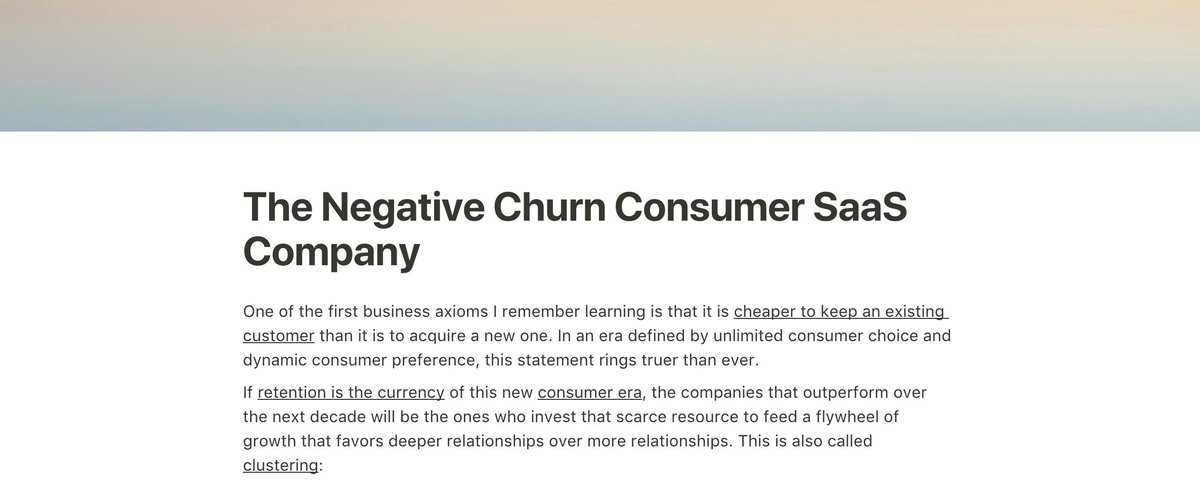Helpful report on the consumer subscription market although I disagree w/ this chart.
The consumer subscription winners over the next decade will have metrics that look a lot like good enterprise SaaS, specifically around net retention.
cc: @joshelman
gpbullhound.com/research/gp-bu…
The consumer subscription winners over the next decade will have metrics that look a lot like good enterprise SaaS, specifically around net retention.
cc: @joshelman
gpbullhound.com/research/gp-bu…

2/ One of the first business axioms I remember learning is that it is cheaper to keep an existing customer than it is to acquire a new one. In an era defined by unlimited consumer choice and dynamic consumer preference, this statement rings truer than ever.
3/ If retention is the currency (@2PMinc / @tracewall) of this new consumer era, the outperformers over the next decade will be the ones who invest that scarce resource to feed a flywheel of growth that favors deeper relationships over more relationships.
2pml.com/2018/12/10/ret…
2pml.com/2018/12/10/ret…
4/ Another way to describe this depth > mass appeal approach to growth is "clustering" which I came across recently in this great piece from @digitallynativ.
medium.com/swlh/why-are-d…
medium.com/swlh/why-are-d…

5/ Within this context, I expect that the best consumer subscription companies will start to resemble Enterprise SaaS companies & a material portion of growth (the most efficient growth) will come from negative churn.
Great data here from @afc ⤵️
medium.com/@alexfclayton/…
Great data here from @afc ⤵️
medium.com/@alexfclayton/…

6/ You can think about this as "climbing the revenue retention ladder".
A great SMB SaaS company has net retention characteristics of a good mid-market or Enterprise SaaS company.
Great Consumer Subscription companies will have Net Dollar Retention of 100% +.
How?
A great SMB SaaS company has net retention characteristics of a good mid-market or Enterprise SaaS company.
Great Consumer Subscription companies will have Net Dollar Retention of 100% +.
How?

7/ In Enterprise SaaS, negative churn tends to come from from 3 things:
1. Seat Expansion
2. Cross Sell
3. Resource Expansion
Drivers of negative churn in consumer subscription are similar but it is worth looking at a couple examples.
tomtunguz.com/negative-churn/
h/t @ttunguz
1. Seat Expansion
2. Cross Sell
3. Resource Expansion
Drivers of negative churn in consumer subscription are similar but it is worth looking at a couple examples.
tomtunguz.com/negative-churn/
h/t @ttunguz

8/ Seat Expansion - Peloton & Spotify
Obviously, there is a lower limit on "seats" when it comes to consumers but both companies have used family packages to charge higher prices over time and drive stronger retention by engaging more users.

Obviously, there is a lower limit on "seats" when it comes to consumers but both companies have used family packages to charge higher prices over time and drive stronger retention by engaging more users.


9/ Cross Sell - Peloton 🚴♀️
Selling a treadmill existing bike owners (or just digital-only members more likely to buy a tread than a bike) or launching physical studios and exposing users to the in person experience.
trueventures.com/blog/peloton-r…
Selling a treadmill existing bike owners (or just digital-only members more likely to buy a tread than a bike) or launching physical studios and exposing users to the in person experience.
trueventures.com/blog/peloton-r…
10/ Resource Expansion - Spotify + Calm
My favorite fantasy M&A scenario. The Gimlet buy hinted at a move towards exclusivity & Calm provides differentiated value that consumers will pay more for (given that 2m of them already subscribe!)
stratechery.com/2019/spotifys-…
@benthompson
My favorite fantasy M&A scenario. The Gimlet buy hinted at a move towards exclusivity & Calm provides differentiated value that consumers will pay more for (given that 2m of them already subscribe!)
stratechery.com/2019/spotifys-…
@benthompson

End/ I was in the process of writing a blog post called "The Negative Churn Consumer SaaS Company" when I came across this report (released today I believe) and realized a thread might be more efficient.
👋
👋

• • •
Missing some Tweet in this thread? You can try to
force a refresh















